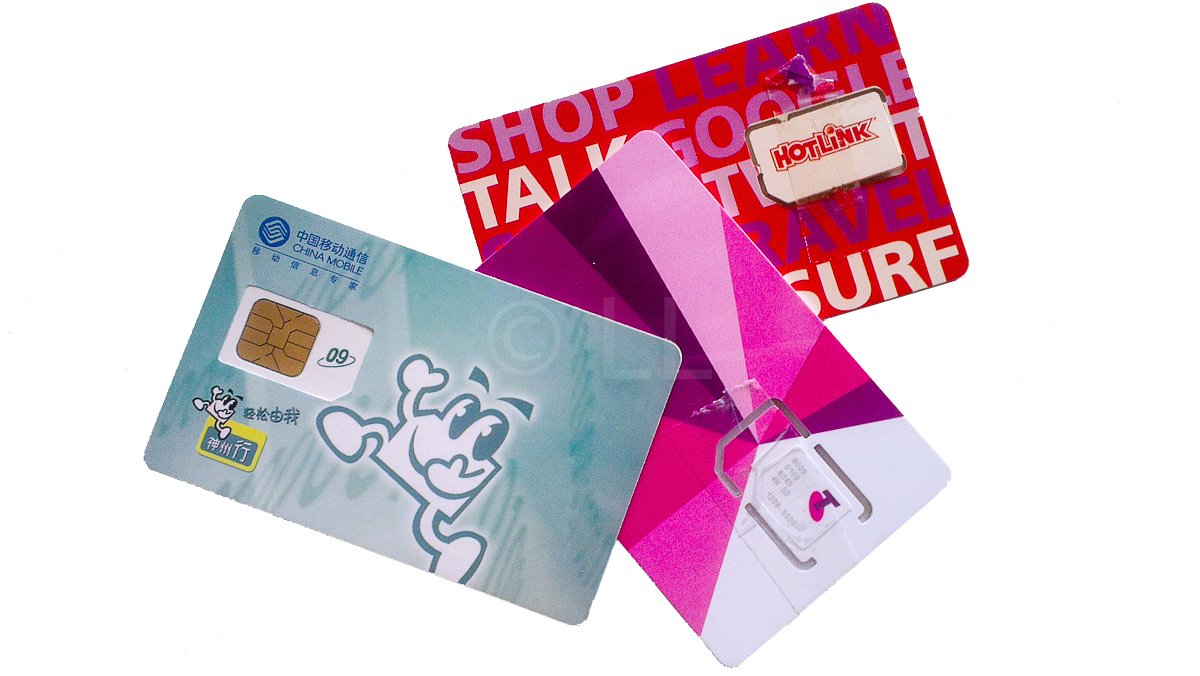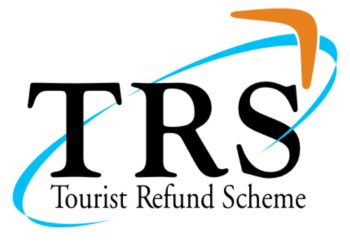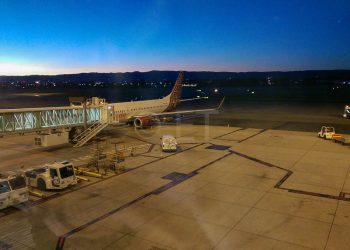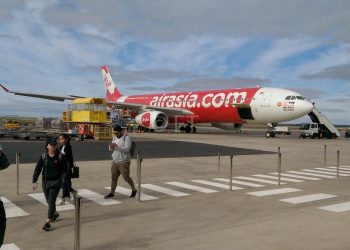We’ve all heard horror stories of people who’ve travelled overseas and made or received a couple of calls and returned home to huge phone bills because they hadn’t turned off their data roaming. These stories aren’t country specific, so the suggestions given here are meant as guidelines which can help you choose the most effective method for you. Only leave your roaming switched on if you are absolutely required to do so by your employer if they are paying. Otherwise, think of your pocket and remove the pain before it arrives.
First Rule (not a guideline, this is a MUST DO!) – turn off your data roaming before you catch the plane. Do it at the same time you enable flight mode if you want to play games or watch video, take photos etc during your flight. Alternative: Check to see if your provider offers a Roaming package for a daily rate. This might be a good deal if you are likely to need to keep in touch.
Local SIM
Benefits:
This may not be a bad idea especially if you have a dual SIM phone. Even if you are unlikely to be making or receiving any local calls, you can tack on a Data plan so you have access to mobile data, useful for email, browsing and using Apps like WhatsApp which are linked to your phone. Make sure you have your passport with you when you register.
Check if there is a call-back facility to your home country or at least a method where calls from a mobile are reduced. e.g Maxis Malaysia offers a Tablet Plan (no calls, just data, though you do need to have a phone which will receive the TAC to activate the account) and IDD and Roaming (Dial a code before your international number and pay a much reduced price).
DigiMobile have a presence in a number of countries including Malaysia. With a number of providers looking for your business, you will find most offer quite competitive rates. You can purchase your Tune mobile card on board your AirAsia flight and UMobile offers competitive rates.
In Singapore, you can look for Singtel pre-paid mobile cards valid for 90 days, or a variety of data card types. If you want both calls and data, the hi!Tourist SIM looks like the best deal.
In Australia, Vodafone, Telstra and Optus all offer competitive rates within Australia for pre-paid cards for calls & SMS and tablet data.
If you haven’t bought your pre-paid local SIM online before you arrive, or on board your flight, you will usually find stalls selling cards as soon as you leave the arrival hall and sometimes even before you reach that point.
In China, you can usually pick up a card when you arrive, ChinaMobile is widely used in both Hong Kong and mainland China. The other two major providers are China Unicom and China Telecom. Unless you’re travelling with a Chinese speaker, it would be best to choose your card at the airport.
If you’re in Malaysia (and soon in other countries) you could try a new service called Hello Roaming which will sell you a local SIM for your destination before you leave home. We’ll be doing a ‘road test on this service and will update the results in our story.
Cautions:
Pre-paid calls are often more expensive than post-paid and in some countries have a big up-front hit before you start counting the time. This writer was caught in China when the local SIM was chewed through very quickly and discovered that it was because it was being used in two different provinces. Otherwise, within the same province, the cost was quite low.
If you are on a post-paid phone plan where you are ‘locked in’ for a certain period, you should see your provider before you go overseas to get the phone unlocked, otherwise you can’t put another SIM in and get it to work.
Within Australia, we’ve tried both Vodafone and Telstra and found that up-front call charges were quite hefty, but a data only card was quite affordable. Coverage was better with Telstra.
In China, certain websites, including Facebook, are not available.
Purchase a roaming card before you leave home
Benefits:
Possibly one of the best compromises is one that allows you to use your own number but purchase roaming facilities separately. Flexiroam allows you to make and receive unlimited roaming calls while you are abroad, but access the benefits of a local data plan. This means that people at home can still contact you using your familiar number without you incurring high roaming charges.
Currently if you are travelling from Australia, Canada, Hong Kong, Indonesia, Malaysia, Singapore, Thailand, UK and US, you can use the service in almost all countries. Truphone offers a similar option though to fewer countries.
Cautions:
Although we haven’t actually road-tested either of these ones, the concept seems fairly sound they may also be handy if you are travelling across a number of different countries.
Check to see if your existing provider offers special roaming rates
Benefits:
Again, a useful way to keep your own number but keep control over your roaming charges. Vodafone offers this service for AU$5 per day in Australia and In New Zealand you can pay NZ$ for 4G roaming, calls and data in 50 countries. Vodafone UK offers the same to over 60 countries from £3 a day. If you have a Vodafone account in another country, most seem to have similar deals.
Telstra Australia does not have easily accessible information on their website. It seems to be necessary to go through a number of steps and then contact them for a proposal. Probably easier to pop into their nearest shop and ask the people at the counter or give them a call.
If you have a Maxis pre or post-paid card in Malaysia, they have variable roaming rates depending on the country you’re visiting. Similarly Digi has similar plans.
Cautions:
It may still be more expensive than getting a local SIM card, but it is convenient if you need to use your own number.
Telstra do have this advice on their website: “From 12 May 2015, International Roaming is automatically active on new Telstra mobile services, whether you’re on a Telstra mobile plan or have a Pre-Paid service.” If you choose not to do so, you have to call them before you leave.
Book accommodation that offers free wifi
Benefits:
This is usually good enough for emails, messages and browsing, but it’s polite not to use up bandwidth watching movies, especially if you are staying in hostel accommodation where many similar minded people will be wanting to use it. Once you get connected, keep in touch using WhatsApp and other similar messaging apps and make calls using such apps as WhatsApp calls, Viber, Tango and Skype.
Cautions:
You may not get wonderful speeds and there may be restrictions on what you can use it for – be considerate, don’t use up the bandwidth watching movies or other heavy guzzlers.
The access may be available throughout the establishment, or it may be restricted to the lobby, or even only to fixed computers in the lobby. But at least you have access!
Patronise establishments offering free wifi
Benefits:
Many businesses, especially coffee outlets, offer free wifi, but please don’t try to squat outside and use it without buying at least a drink!
Cautions:
Because your connection won’t have the same level of security as your home connection, don’t use it for banking or other sensitive business. You may need to provide a local number to receive a verification code.
Check if there is city-wide, public transport and airport free wifi available
Benefits:
Many cities are now offering free wifi, either city wide or in hotspots located in strategic areas. Among the cities with this service, you will find Paris, Perth CBD, Penang and a number of cities and towns across the US. Check on your phone to see if you are in a wifi zone.
Taipei is a great place for free wifi and you can get 30 days free if you register before you arrive. Other cities where you can get free access include Tel Aviv and Macau and if you purchase a Firenze Card multi-museum pass in Florence, you’ll get 72 hours of free internet as well.
We found the wifi was free on our Airport train in Brisbane, very useful for letting people know when you’re arriving.
In addition a number of airlines are hopping on board to make wifi available, but for now, the range of costs is wide – from free to expensive.
Cautions:
There may be some restrictions. In airports, We weren’t able to use WhatsApp in Qatar’s Hamad International Airport, but browsing worked fine. Singapore’s Changi had restrictions on the length of time you can use the service though they do have kiosks scattered about the transit areas where you can browse or check your mail for free.
Some services need a verification code to be sent to a local mobile number which you need to provide.
***TIP Remember that public free wifi is just that – public. Don’t use if you do sensitive business like banking transactions. This applies equally to free city wifi as it does to that offered by businesses.







This Post Has 0 Comments